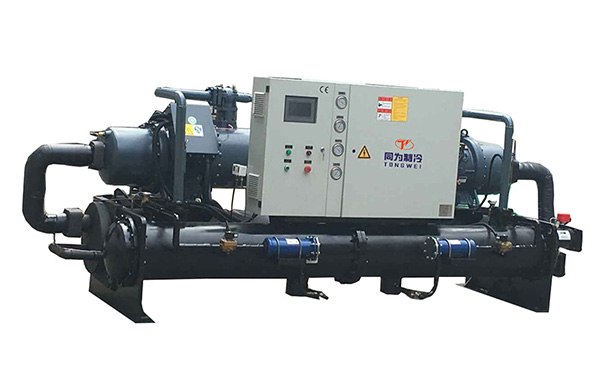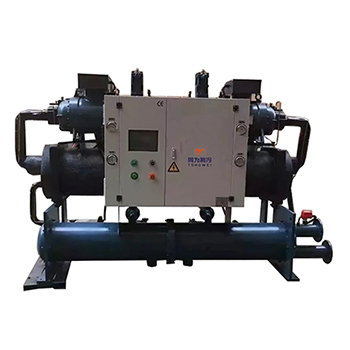1.What is cement?
Cement is a mixture of calcium carbonate, silica, alumina and ferrous oxide, which occur naturally in limestone, chalk, shale and/or clay.
During the cement production process, these minerals are fused together by heating to just below their melting point, forming cement clinker with a diameter between 3 and 20 millimeters. Pure cement is formed by grinding cement clinker into a fine powder.
Gypsum is added to this powder in order to regulate the way cement mortar or concrete sets. Gypsum is a mineral composed of hydrated calcium sulfate, which affects the reactivity of cement with water. Cement is combined with water, aggregate and sand to form concrete, or alone with sand to form mortar. Once hardened, these are the stronger building materials we are more familiar with.
2.What is Cement Cooling Chiller?
A Cement Cooling Chiller is a specialized refrigeration system used in cement production plants to regulate and control the temperature of the cement-making process. Cement manufacturing involves several stages, including the grinding and blending of raw materials, the formation of clinker, and the final milling. Temperature control is crucial at various points in this process to ensure the quality and performance of the final cement product.
3.What’s the Difference Between Air-cooled & Water-cooled Cement Cooling Chillers?
There are two types of Cement Cooling chiller: one is air-cooled Cement Cooling chiller ,the other is water-cooled Cement Cooling chiller ;
Air-cooled Cement Cooling chillers use ambient air to dissipate heat from the brewing processes. They are energy-efficient, space-saving, and less maintenance that helps save money.
Water-cooled Cement Cooling chillers use water from an external water cooling tower to dissipate heat from the brewing processes. These systems are longer lifespan, Relatively quiet, and more consistent cooling performance than the air-cooled Cement Cooling chiller.

Air-cooled Cement Cooling Chiller Installation Drawing
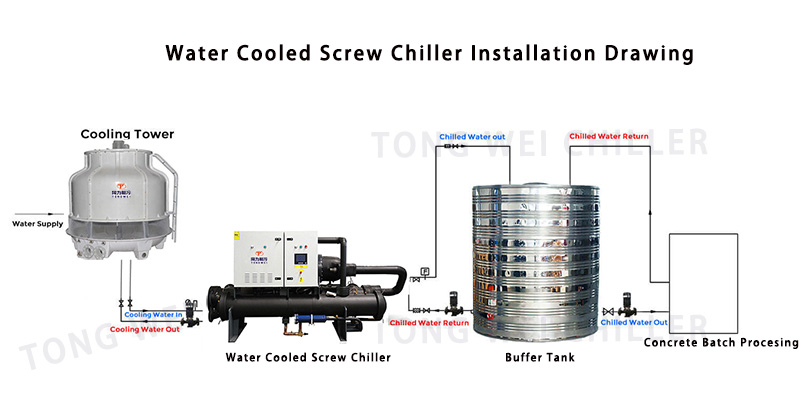
Water-cooled Cement Cooling Chiller Installation Drawing
Should you choose an air-cooled or water-cooled Cement Cooling chiller? Contact Us for help determining the best solution for you.
4.What is the Difference Between Cement Cooling Scroll Chiller and Cement Cooling Screw Chiller?
Cement Cooling Scroll Chiller Cement Cooling Screw Chiller
▪1/2 HP-60HP(2KW-170KW) Above 60HP(Above 170KW)
▪ Danfoss/Panasonic Scroll Compressor Hanbell/Bitzer Screw compressor
▪Built with water tank and water pump Without water tank and water pump

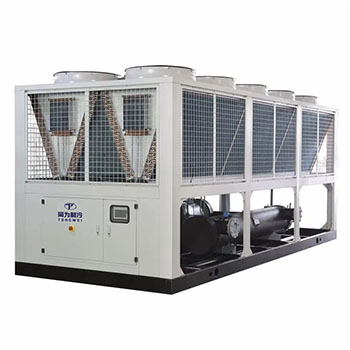
Air-cooled Cement Cooling Scroll Chiller Air-cooled Cement Cooling Screw Chiller
Water-cooled Cement Cooling Scroll Chiller Water-cooled Cement Cooling Screw Chiller
5.What Are The Main Components of Cement Cooling Chillers?
5.1 Compressor
The compressor is the key mover in water chiller because it produces pressure variations to stir the refrigerant around.
From 1/2HP(1/2 Ton) to 60HP(5oTon) Cement Cooling chiller , which is with Panasonic or Danfoss brand Scroll compressor ,
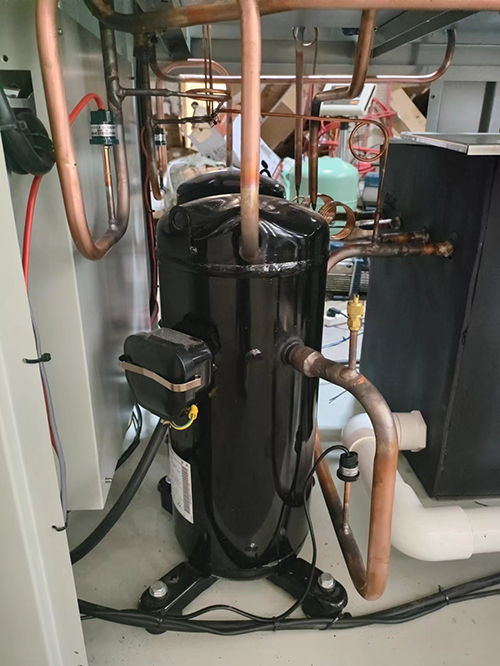 Panasonic Compressor
Panasonic Compressor

Danfoss Compressor
5.2 Evaporator
The evaporator is a crucial component of air-cooled water chiller, as it is responsible for extracting heat from the liquid being cooled,it is located between the compressor and the expansion valve. There are three types of evaporators : coil in water tank evaporator , shell and tube evaporator, 304SS stainless steel plate type evaporator.
 Coil in SS Water Tank Evaporator
Coil in SS Water Tank Evaporator
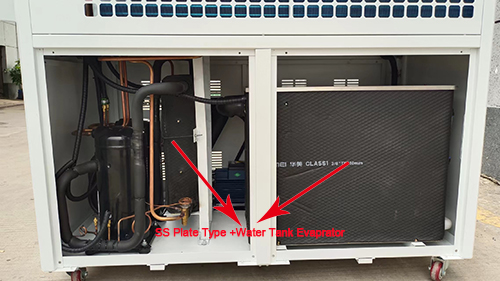
SS Plate Type+ Water Tank Evaporator
 Shell and Tube Evaporator
Shell and Tube Evaporator
5.3 Water Pump
The water pump is designed to increase the pressure and the flow of the chilled water in a closed space.

Water Pump

High Pressure Water Pump
5.4 Condenser
The condenser for air-cooled Cement Cooling cooler is equipped with efficient cross-seam fins and female threaded copper tubes for high heat exchange efficiency and good stability.Its function is to cool down the refrigerant steam released from the compressor into a liquid or gas-liquid mixture.
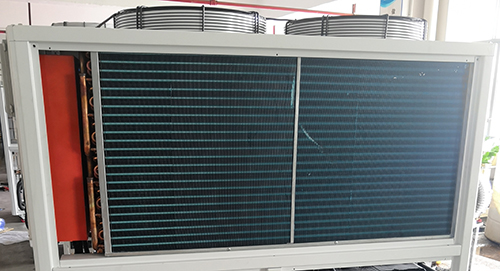
Aluminum fin+fan Condenser for air -cooled Cement Cooling chiller
The condenser for water-cooled Cement Cooling cooler is shell and tube ,with the internal copper tubes employing an outer thread embossing process.This design effectively enhances the heat exchange efficiency between the refrigerant and water during the process. Compared to traditional smooth copper tubes, the outer thread embossing process increases the surface area of the copper tubes, thereby expanding the contact area for heat exchange and improving the thermal conductivity of the condenser. This optimization design allows the condenser of the water-cooled chiller to transfer heat from the refrigerant to the water more rapidly and consistently, enabling the water to carry away the heat.

Shell and tube Condenser for water-cooled waterjet cuttting chiller
5.5 Controller Panel
Water chillers use precision digital temperature controller, it RS485 communication port,which can do remote monitoring and control. Simple operation, low failure rate, high safety factor, easy installation.
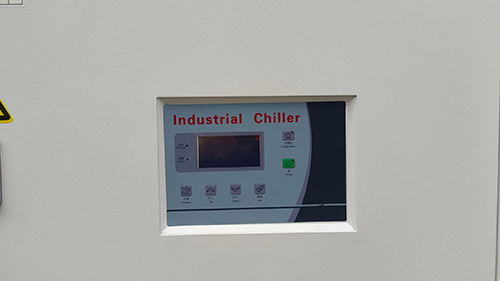
Controller Panel
6.How to Choose Right Chiller for Your Cement Cooling Process?
How to calculate right cooling capacity for your Cement Cooling chillers?
One of the most frequently ask about how we can know the cooling capacity for chillers.
The range of a chiller at which it can discharge heat from a heated fluid is called cooling capacity.
The cooling capacity of a laser Chiller ranges from 1/2KW to 100KW.
Let’s see the below formula.
Cooling Capacity(kw)= Flow Rate(m3/h)*Temp Change(T1-T2)/0.86
Heat Load= C(specific heat)* M(quality output per hour )*Temp Change(T1-T2)
Oversize the chiller by 20% Ideal Size in KW = KW x 1.2
Noted : T1:Incoming Water Temperature (℃) T2:Required Chilled Water Temperature(℃)
For example, what size of chiller is required to cool 5m³ water from 25°c to 15 °c in 1 hour?
Temperature Differential = 25℃-15℃=10℃
Water Flow Rate = 5 m³/hour
Cooling Capacity in KW = 5 x 10 ÷ 0.86 = 58,14 KW
Oversize the chiller = 58.14 x 1.2 = 69.76 KW
69.96kw cooling capacity for chiller is required.
Types of Cement Cooling chiller system?
There are two types of chiller :Air Cooled Cement Cooling Chiller and Water Cooled Cement Cooling Chiller.
Water cooled chiller needs a separated water cooling tower and water cooling pump ,if you don‘t have exsiting water cooling tower,we suggest you use air cooled chiller; But if your ambiemt temperature is very high above 55℃ ,we suggest you use water cooled chiller , as it is easier to dissipate heat for water cooled chiller with water cooling tower.
Whether chillers need built-in Tank or not?
In a chiller system, a tank is usually equipped to buffer the thermal load of the chiller.
But should we choose a built-in type of tank or an external type of tank?
A chiller with a built-in tank is easier to install and can be used simply by connecting a water pipe to your application.
But it has a limited capacity and is not suitable for applications with larger chilled water demands.External tank’s capacity can be customized according to specific needs.
It can buffer a larger heat load, store more chilled water, but the installation will be more troublesome.
If you don‘t have external water tank ,we suggest our chiller built-with water tank ,which is easy for you to install.
Cooling capacity unit conversion?
1 KW=860 kcal/h ;
1 TON=3.517 KW;
1 KW=3412 Btu/h;
7.Contact Us to Learn More About Our Cement Cooling Chillers
We engineer and produce high-quality process chillers compatible with a broad range of industrial processes.
Depending on your needs, we also offer custom chillers to ensure that each client receives the industrial chiller best suited to their unique process.
Request a quote now on our Cement Cooling water chillers or learn about the other air-cooled chillers and water-cooled chillers.
















